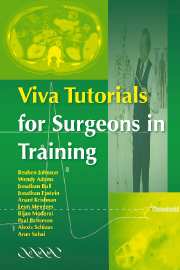5 - Surgical Pathology
Published online by Cambridge University Press: 12 August 2009
Summary
GROWTH AND DIFFERENTIATION
Hyperplasia and Hypertrophy
Define hypertrophy.
The growth of a tissue or organ because cells increase in size without cell replication.
Define hyperplasia.
The growth of a tissue or organ because there is an increase in the number of cells due to cell division.
Give a physiological and pathological cause of hypertrophy.
Muscles undergo hypertrophy with exercise while cardiomyopathies involve heart muscle hypertrophy.
Give a physiological and pathological cause of hyperplasia.
Hyperplasia takes place in the breast during puberty and pregnancy while adrenal hyperplasia characterises Cushing's disease.
Can you name any conditions in which hypertrophy and hyperplasia occur in the same organ?
Benign prostatic enlargement.
Grave's disease of the thyroid.
What is autonomous hyperplasia?
Proliferation in the absence of a demonstrable stimulus as in psoriasis and Paget's disease of bone. This falls very close to the definition of neoplasia.
Metaplasia
Define metaplasia.
The reversible change of one fully differentiated cell type to another.
Can you give an example?
In Barrett's oesophagus the distal stratified squamous epithelium is replaced by columnar epithelium like that present in the proximal stomach.
What mechanism is thought to be responsible?
Prolonged gastro-oesophageal reflux leads to inflammation and eventually ulceration. Healing occurs by re-epithelialisation, which in the acidic environment created by gastro-oesophageal reflux disease (GORD) differentiate into gastric or intestinal type epithelium. These are more resistant to injury from gastric contents.
Information
- Type
- Chapter
- Information
- Viva Tutorials for Surgeons in Training , pp. 177 - 220Publisher: Cambridge University PressPrint publication year: 2004
